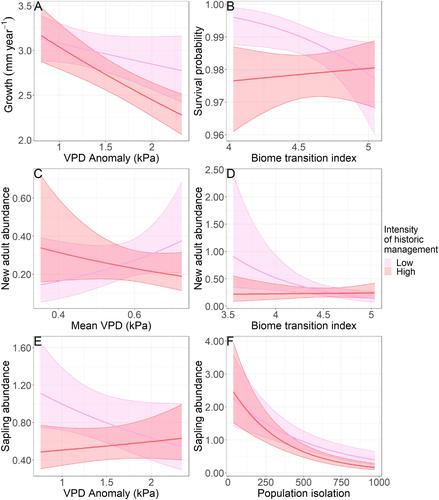当前位置:
X-MOL 学术
›
Glob. Change Biol.
›
论文详情
Our official English website, www.x-mol.net, welcomes your
feedback! (Note: you will need to create a separate account there.)
Historic Land Use Modifies Impacts of Climate and Isolation in Rear Edge European Beech (Fagus sylvatica L.) Populations
Global Change Biology ( IF 10.8 ) Pub Date : 2024-11-05 , DOI: 10.1111/gcb.17563 Jazz Rhoades, Albert Vilà‐Cabrera, Paloma Ruiz‐Benito, James M. Bullock, Alistair S. Jump, Daniel Chapman
Global Change Biology ( IF 10.8 ) Pub Date : 2024-11-05 , DOI: 10.1111/gcb.17563 Jazz Rhoades, Albert Vilà‐Cabrera, Paloma Ruiz‐Benito, James M. Bullock, Alistair S. Jump, Daniel Chapman

|
Legacies of human land use have the potential to impact demographic responses to climate. However, few studies have investigated the interactive effects of land use legacies and climate change on tree demography. The demographic performance of rear edge populations in particular is an important determinant of a species' long‐term persistence. In this study, we investigated whether human land use legacies affect demographic responses to climate and population isolation in rear edge European beech populations (Fagus sylvatica L .) at the temperate‐Mediterranean transition zone in the NE Iberian Peninsula. We utilised data from the Spanish Forest Inventory and generalised linear mixed models to compare the potential interactions across four different demographic rates (tree growth, survival probability, new adult recruitment and sapling recruitment). We found that the demographic rates were affected by the combination of land use legacies, climate and population isolation in different ways, which could potentially lead to complex shifts in future population dynamics under climate change. We identified that intense historic management either magnified negative relationships between tree demography and climate or population isolation, or reduced demographic performance in favourable climates to levels observed in unfavourable climates. Through either form of interaction, we found that intense historic forest management had a negative impact on tree demography, which has the potential to compromise future carbon stocks and long‐term population viability. Overall, we show that disentangling human and environmental factors can enable us to better understand heterogeneous demographic performance across the rear edge of species distributions.
中文翻译:

历史土地利用改变了气候和隔离对后缘欧洲山毛榉 (Fagus sylvatica L.) 的影响人口
人类土地利用的遗留问题有可能影响人口对气候的反应。然而,很少有研究调查土地利用遗留和气候变化对树木人口的交互影响。特别是后缘种群的种群表现是一个物种长期存在的重要决定因素。在这项研究中,我们调查了人类土地利用遗留问题是否会影响伊比利亚半岛东北部温带-地中海过渡区后缘欧洲山毛榉种群 (Fagus sylvatica L.) 对气候和种群隔离的人口反应。我们利用来自西班牙森林清查的数据和广义线性混合模型来比较四种不同人口统计率(树木生长、生存概率、新成虫招募和幼苗招募)的潜在相互作用。我们发现,人口增长率以不同的方式受到土地利用遗留、气候和人口隔离组合的影响,这可能导致气候变化下未来人口动态的复杂变化。我们发现,密集的历史管理要么放大了树木种群与气候或种群隔离之间的负关系,要么将有利气候下的种群表现降低到不利气候下观察到的水平。通过这两种形式的互动,我们发现密集的历史森林管理对树木人口统计学产生了负面影响,这有可能损害未来的碳储量和长期种群生存能力。总体而言,我们表明,解开人类和环境因素可以使我们能够更好地了解物种分布后缘的异质人口表现。
更新日期:2024-11-05
中文翻译:

历史土地利用改变了气候和隔离对后缘欧洲山毛榉 (Fagus sylvatica L.) 的影响人口
人类土地利用的遗留问题有可能影响人口对气候的反应。然而,很少有研究调查土地利用遗留和气候变化对树木人口的交互影响。特别是后缘种群的种群表现是一个物种长期存在的重要决定因素。在这项研究中,我们调查了人类土地利用遗留问题是否会影响伊比利亚半岛东北部温带-地中海过渡区后缘欧洲山毛榉种群 (Fagus sylvatica L.) 对气候和种群隔离的人口反应。我们利用来自西班牙森林清查的数据和广义线性混合模型来比较四种不同人口统计率(树木生长、生存概率、新成虫招募和幼苗招募)的潜在相互作用。我们发现,人口增长率以不同的方式受到土地利用遗留、气候和人口隔离组合的影响,这可能导致气候变化下未来人口动态的复杂变化。我们发现,密集的历史管理要么放大了树木种群与气候或种群隔离之间的负关系,要么将有利气候下的种群表现降低到不利气候下观察到的水平。通过这两种形式的互动,我们发现密集的历史森林管理对树木人口统计学产生了负面影响,这有可能损害未来的碳储量和长期种群生存能力。总体而言,我们表明,解开人类和环境因素可以使我们能够更好地了解物种分布后缘的异质人口表现。


















































 京公网安备 11010802027423号
京公网安备 11010802027423号